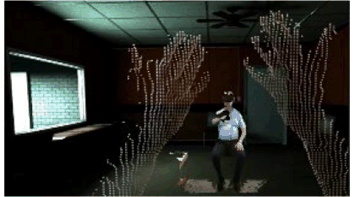Content for TR 26.928 Word version: 18.0.0
0…
4…
4.1.2…
4.2…
4.3…
4.4…
4.5…
4.6…
4.6.7
4.7…
4.9…
5…
6…
7…
8
A…
A.4…
A.7…
A.10…
A.13
A.14
A.15
A.16
A.17
A.18…
A.14 Use Case 13: 3D shared experience p. 104
|
Use Case Description:
3D shared experience
|
|---|
In this shared 3D use case two friends (Eilean and Bob) are sharing a virtual experience. The experience builds around a crime investigation showing an investigation of two murder suspects and allowing the users to discuss and identify who committed the murder. Both Eileen and Bob are joining from home wearing a VR HMD and being captured via an RGB+depth camera. In VR they experience a 3-dimensional room (6DOF, police station), being represented in 3D and including a self-representation that allows them to point at items in the room and at each other. This representation can be based on the same capture that is made with the RGB+depth camera for communication purposes. Further, in the virtual police station each one of them has a window to follow a different interrogation (windowed 6DOF / 3DOF+), allowing them to collect information to solve the murder together (see Figure A.14-1).

Figure A.14-1: example image of a virtual 3D experience with photo-realistic user representations
(⇒ copy of original 3GPP image) |
| Categorization |
|
Type:
AR, MR, VR
Degrees of Freedom:
3DoF+ / 6DOF
Delivery:
Conversational
Device:
Mobile / Laptop
|
| Preconditions |
The above use case results into the following hardware requirements:
|
| Requirements and QoS/QoE Considerations |
The following QoS requirements are considered:
|
| Feasibility |
Demos & Technology overview:

Furthermore to realize this use case it is mapped into the following functional blocks:
|
| Potential Standardization Status and Needs |
The following aspects may require standardization work:
|